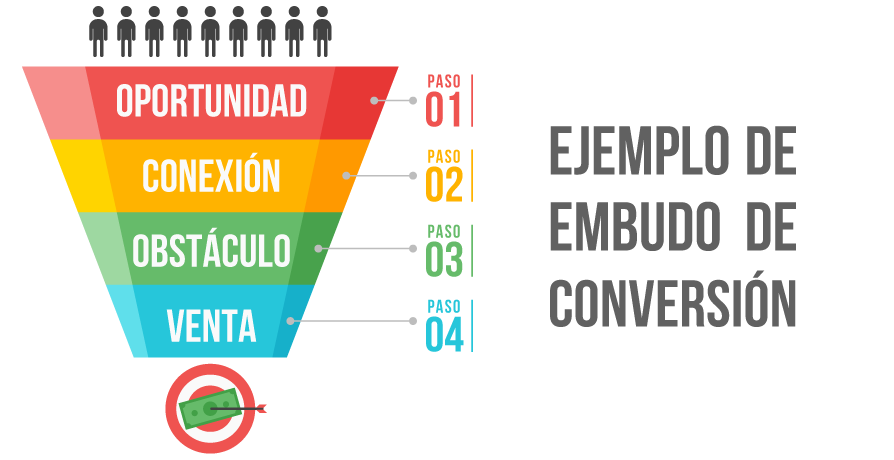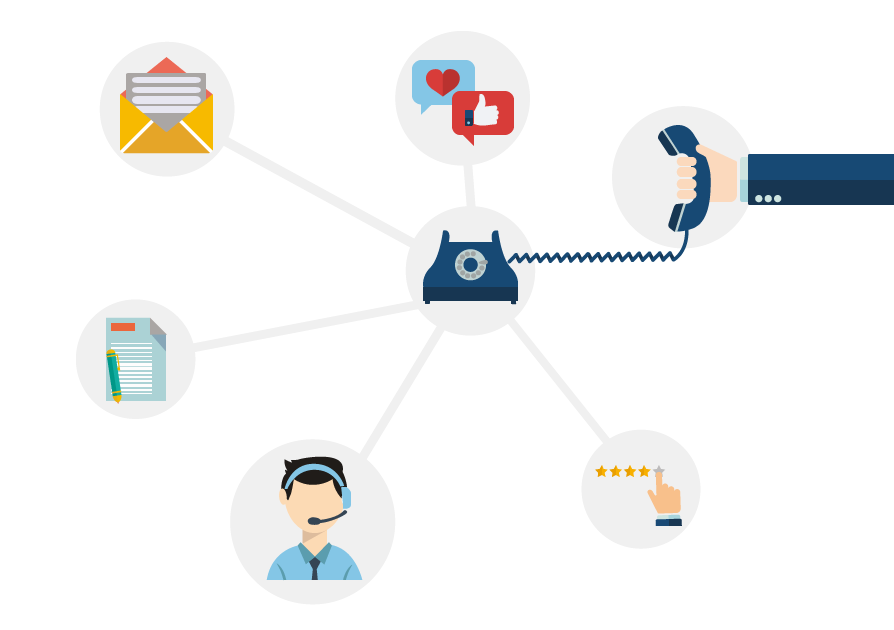A good digital marketing strategy is indispensable for any modern business. Especially since the Internet offers an ocean of potential customers. No matter who your target audience is or where they live, you can find them on the Internet.
However, there are many companies that are not taking advantage of this vast market of customers. Some of them fail in executing their digital marketing strategy… others don’t even have a strategy!
A company that falls asleep is carried away by the current.
A bad digital marketing strategy will cost you more than just money and time. It can cost you the loss of your current customers and even ruin your reputation. And we don't want that to happen.
That's why we present you this list of the 26 mistakes you should not make in 2020 in your digital marketing strategy. If you want to get ahead of any topic, you can do so from the error index:
- Digital marketing and basics
- SEO
- Social networks
- Content Marketing
- Email marketing
- Website and technical aspects
- Marketing campaigns
Basic mistakes in your Digital Marketing strategy
1. Not putting customer experience first
Amazon CEO Jeff Bezos described how customer relationships work perfectly: “If you make your customers unhappy in the physical world, they will tell 6 friends. If you make your customers unhappy online, they will tell 6,000 other customers.“.
Pay attention to what your customers are saying. Even if you don't offer 24/7 support, respond quickly to every user who contacts you.
Your interactions with customers on social media are public. Your responses define your brand and show your audience how much you value them.
Customer experience is vital. And thanks to social media, complaining online is easy and viral. That's why you should try to give every customer a great experience.
2. Not having a conversion funnel
Connecting with your audience is key on social media. Attracting traffic and getting conversions should be one of your priorities.
A conversion funnel is a series of steps to convert a visitor into a customer. It is a way to visualize and understand the flow and conversion of your visitors. It will help you identify what you can offer your visitors, based on their needs, to make them follow your brand.

Having a conversion funnel will help you stay focused on your digital marketing strategy. You will convert your visitors into users, your users into customers, and your customers into evangelists of your brand.
3. Thinking you have all the time in the world
When we start planning our digital marketing strategy, we are very optimistic. We set goals as if our team had no social life. And what happens at the end of the year? Our optimism takes its toll on us with poor performance.
Remember: you don't have 48 hours a day to execute your strategy. And even if you did, you can't plan absolutely everything: you'll always have unforeseen events. Especially in the world of digital marketing.
Try to be realistic when setting goals for the year. Analyze your time and your capabilities. If you want to position your website, but don't know how, hire a SEO expert companyIt will be more profitable for you to hire someone who knows what they are doing, than to learn on the job.
4. Forgetting your current customers
This may be the most costly mistake on the entire list. Never forget about your current customers. Getting new customers is a constant challenge in digital marketing. But these are not the only customers that matter.
It costs 4 to 10 times more to acquire a new customer than to retain an existing one.This is stated by the Chartered Institute of Marketing.

The easiest way to keep your current customers engaged is by listening to them. Talk to them and find out why they use your products or services. Understand this and you can continue to surprise them with memorable experiences.
5. Not defining concrete objectives in the digital marketing strategy
Most businesses want to make more money or attract more customers online. But they don't have concrete goals in their digital marketing strategies. This lack of clarity can mislead them.
For example, a company that achieved 1.5% more conversions in the year may think that its strategy was a success. When in reality, it could have grown by 22% if it had implemented other digital marketing actions.
Set concrete, clear, realistic, and measurable goals for your 2021 digital marketing strategy (don’t forget to include coping mechanisms for a possible quarantine). Will these goals be set in stone? Of course not. Over the course of the year, you can add or remove goals, depending on how you’re doing. Clear objectives will help you direct your digital marketing actions in the right direction.
Define what you expect from the year in figures that you can measure. You can measure, for example, in KPIs (key performance indicators). But what criteria do you need to establish a KPI? You must make sure that it is specific, measurable, achievable, realistic and time-bound.
Remember: goals are a starting point for your digital marketing strategy. They will help you stay focused.
6. Having a brand without personality
When it comes to marketing, branding plays a very important role. Without a brand, it would be impossible to promote your offices, your stores or your product individually. Your brand brings together all your products, services, values and beliefs into a single concept. And of course, your brand reflects your company's personality. Or at least, it should.
Finding your company's personality through your brand is a very laborious process. By Googling you can find many guides that will teach you how to create a brand for free. But if you are serious about your business, you will let real professionals in the field do this process.
Don't try to please everyone in your communication, this will make you look like a weak brand. For example, if you sell synthetic shoes and you are against bullfighting, make it known. Many people who are also against bullfighting will join you and you will create a community. Don't be afraid to take clear positions on controversial issues.
Having a brand with a defined personality will help you gain real followers. It will make people who think like you follow you and identify with you. And these people will be more inclined to to buy from you rather than your competitionThey will even recommend you and take you where they go (like followers of Harley-Davidson). This is called brand loyalty.
7. Believing that you are alone in the world
Sometimes so much work can make you forget that you have competition. Lots of competition: hundreds of companies that work daily to take your clients away. I'm not exaggerating.
Constantly monitor and analyze your competition. Observe what lies behind their successes. Learn from each of their mistakes. Or at least from those you can identify.
Also, make connections with marketing colleagues, even if they don't work in your industry. On the contrary, it's much better if they work in another industry. Create allies and share the challenges of your digital marketing strategy with them. It's quite possible that from their perspective they can contribute invaluable things to your strategy.
8. Not investing the necessary time
Doing digital marketing is a lot like being in the stock market on a hectic day. You have to be aware of each of your investments moment by moment. You need to maximize the return on investment and get all the benefits possible.
If you don't spend enough time monitoring your campaigns, you risk losing money. You'll be investing in visitors you can't convert into customers. Or in promotions that lead to nothing. Or perhaps in SEO activities that will be easily outperformed by the competition.
Review the results of your digital marketing actions on a daily basis. Pay attention to the metrics and how your audience is responding. With this data in mind, optimize your campaigns.
SEO mistakes
9. Believing that SEO is a postmodern myth
There are a number of myths about SEO. Some marketing experts claim that SEO is dead. Those same experts also claim that witches exist and that they went to Narnia in December.
We are in the age of artificial intelligence and advanced algorithms. And yet there are people who dare to ignore SEO in their digital marketing strategies. Those people are the ones who lead their websites into oblivion, of course.

Without an understanding of SEO, your digital marketing strategy actions will fail. You will have fewer visitors, so you will convert much less. SEO, even if some people don't want it, remains one of the pillars of web presence.
You don't need to know absolutely everything about SEO. If you learn the basics of SEO, you'll be fine. Or you can relax about it and hire a company specialized in SEO.
10. Not identifying the right keywords for you
Many clients ask us the same question: how can I be on the first page of Google?
The answer is always the same: it can't be done.
You can't be omnipresent on Google. Even Wikipedia, which has everything for everyone, can't do that.
Oh, you meant being on the first page of Google when someone searches for “fast food”? That’s it. if possible.
That's why it's so important to discover the perfect keywords for your business. This way you can tell people what you offer. exactly what they are looking for.
Now, you'll want to rank for keywords that have a lot of traffic. Being the best result for a topic that no one is searching for will do you little good. Ranking for keywords with traffic will allow you to attract new traffic to your website.
Tip: Use Google Keyword PlannerYou will be able to find the perfect keywords for you and useful for your target audience.
11. Leaving aside metrics and analytics
Every time someone visits your website, hundreds of pieces of data are generated. How did they get there? Where do they live? How long did they spend on your website? Which pages did they like the most? Which page did they leave on? All of these questions can be answered with Google Analytics in just one click.
And Google isn't the only one offering analytics: Facebook, Instagram and Twitter do too.
Successful digital marketing campaigns don't happen on the first try. They are the product of a long process of trial and error, of analysis and measurements, of rinsing and repeating.
When we launch a campaign we identify what our audience liked the most and what they liked the least. What our audience liked the most we will try to put into other campaigns. Whereas what our audience liked the least, we will never use again. Never, ever, ever.
You need to get data on everything. It is better to have data and not use it, than to need it and not have it. The data can tell you that your real audience is the Benedictine monks of Tibatí. And meanwhile, you are trying to sell to men and women, aged 22 to 35, from the capital who love cinema.
Using metrics will help you understand the return on investment (ROI) of your campaigns. You will be able to know if you are meeting your goals or if you are moving away from them.
Mistakes in your Social Networks
12. Ignoring your Social Networks
“I have notifications on my social networks! What if it is a complaint? I better not open the message and everything will magically be solved.” These were the last words of a Community Manager before being fired. And with just cause.
The easiest way for your audience to talk to you is through social media. When someone talks to you, listen and respond. They will thank you by being loyal and, why not, by telling their friends about you.
If you manage your networks well, you will see that interactions will start to happen naturally. And most of them will be positive.
13. Be “active” on many social networks
Having a social media account is like having a storefront for your business. A storefront in the most populated place in the world, open 24 hours a day and staffed by the most intolerant people in existence.
Just like in a store, each social media account should have an administrator. Someone who greets people who come in, who takes customer complaints. Someone who changes product prices and the contents of the display case every day. Otherwise, people will not come into your store and those who came in before will stop visiting you.
Every social network needs special care. Social networks are fueled by content and time; at the very least. If you can't create content for your networks or interact with your audience, you'd better stay away from them. Mismanaging a social network in the era of Social Media can play against you very publicly.
Mistakes in content marketing
14. Not focusing on offering value
Why should someone visit your website or click on your ads? Are you solving someone's problem? Are you helpful to the people who visit you? It's very difficult to find websites that genuinely care about providing value. That's why these sites are so successful.
Look at the case of Wikipedia. A website that offers free information about almost everything. Its visitors need to find out about something and they find just that. Complete and thorough information. However, it is not Wikipedia the one that generates that information: it is its own visitors! And they do it because they believe in what Wikipedia believes: that all people can access knowledge.
Every company has, or at least should have, a value proposition. But not every company knows how to communicate it. If you're having trouble finding your value proposition, think about how your company started. What was the problem you wanted to solve and why?
Great companies start because they want to create change. Microsoft wanted to empower the common man to reach his full potential. Apple I wanted to give people tools to challenge the status quo.
Stay true to your value proposition and you will see that your digital marketing strategy will be a success.
15. Neglecting your target audience
You think you're the Superman of marketing, until you realize that you haven't posted anything on your blog for 5 months. It's happened to all of us.
Your audience feeds on your content. If your content solves your audience's problems, all the better. And if it's high quality, even better.
A good technique to avoid neglecting your audience is to create a publication calendar. Write down the topics that interest your visitors the most and prepare to write about them periodically.
Remind your target audience that they are on your mind, always. Not all of your content has to be 3,000-word articles. Sometimes, a simple thank you message on social media will do the trick.
16. Just try to sell, sell, sell
Yes, sales are essential for maintaining and growing your business. But trying to convert every visit into a purchase can be annoying for your visitors.
If you're looking to sell more than you're looking to be useful to your visitors, you're making a mistake.In the long run, this mistake will cause you to sell much less than you expected. Because nobody likes to be sold all the time.

The key to content marketing is to educate first, sell later. Your goal should be to teach your visitor how to solve their problem. Only after teaching, you can include your call to action. At the end of the article, for example.
If you manage to help someone, they will thank you. Whether it's by telling their friends, subscribing to your website or showing interest in your services.
Connect with your visitors, offer them value and make them fall in love with your brand. After that, they will be ready to buy anything from you.
17. Not creating valuable content
It doesn't matter when you publish your content or who you're writing to. If your content is poor, it won't be well received. If you're lucky, Google will put you on page 50 of search results.
If a user reads your content, they won't be able to get much out of it. If your reader has to wade through spelling or grammatical errors, you've lost them. Your reader won't be focused on your content, but on your mistakes. Bad content drives visitors away from your site.
Valuable content, on the other hand, will help you reach your target audience. But what makes content valuable? Usefulness: Your content must satisfy the needs of your visitors.
To create quality content you need to get inside your visitors' heads. Identify the questions they have and answer them through your content.
Email marketing mistakes
18. Not increasing your subscribers
A study determined that email marketing gives you the 246% ROI for midsize businessesSo if you're not growing your email list, you're making a mistake. A large, segmented email database is every marketer's dream.
Derek Halpern, creator of socialtriggers, conducted an experiment to test the effectiveness of mailing. Sent the same link to the same number of people: some by Twitter and others by email. From Twitter followers it got 300 clicks. While the same link sent by email to the same number of people generated 4,200 clicks.
The effectiveness of the emails in Derek's experiment was due to two factors:
- The relationship between incoming emails and Twitter updatesYou're much more likely to open an email during the day than check your entire Twitter timeline.
- The trust of those who sign up to your mailing listThey signed up because they believe your content provides value to them. So, if they have free time, they will open the emails you send them.
Creating an email list is less complicated than you think. You must offer valuable content for your future subscribers and make it easy for them to subscribe. Place your registration form in a visible place and guide your visitor's path to it.
The more people visit your website, the more opportunities you have to convert them into customers. That is: More visitors, more clicks, more money.
19. Spamming or bombarding your followers' emails
As we mentioned in the previous point: sending emails to your subscriber list can increase your ROI 246%. As long as these emails contain valuable content for your subscribers. Otherwise, you may be sent to a spam list from which you can never get off again.
Losing subscribers should be the least of your worries. More subscribers would rather mark you as spam than unsubscribe. If too many subscribers mark you as spam, your mailing server may temporarily disable you. It could even permanently delete your account. And you don't want that to happen, right?

When a subscriber marks you as spam, they are complaining about your content. You may be sending them content they didn't subscribe to, or they are receiving too many emails. In short: they are not interested in the emails you are sending them.
Every time you are flagged as spam, your server gives you an abuse point. If you reach a high abuse rate, you will receive a penalty. A percentage of abuse is greater than 0.04%, so be extremely careful.
Technical and not so technical errors on your website
20. Not including any call to action on your website
After a visitor enters your website and reads your first page, what should they do? Do you want them to click a button? Leave their details, call you, or buy a product from you? Don't let your visitor guess.
Your visitors won't know what to do on your website unless you point them in the right direction. And how can you do this? With a specific call to action.
“Sign up and get 20% off”, “Buy 1 Get 2”, “Click and get free advice”. These types of calls to action tell your visitors what to expect from your website. And if you have a great web design, much better.
If you need help, This article will teach you how to convert your visitors into customers..
21. Having a slow website
If your website is slow, it doesn't matter if you have the best digital marketing strategy. If your website hasn't loaded in 3 seconds, 57% of your visitors will leave your website.
Your website's excessive loading time can be due to several reasons. It could be bad programming, too many scripts, very large images or slow hosting.
There are many free tools that will tell you the speed of your website - use them. You can get good results with Google PageSpeed Insights, GTmetrix either PingdomThese tools will help you detect what is slowing down your website.
If your website has a speed problem, you need to fix it as soon as possible.
22. Not optimizing your website conversions
Forgetting to optimize your website is the best recipe for failure on the internet. Optimizing your website's conversions is much easier than it seems. It's a trial and error process, but with data in between.
You don't need to have any technical knowledge in programming or analytics. You just need to pay attention to some metrics and tweak your page constantly.

A good way to optimize your website is with A/B testing. Two almost identical pages, with changes in the text, images or calls to action.
Metrics will tell you which version is most effective at driving conversions. Pick the winning version and compare it with a new, improved version of the same version. And repeat the process. There are no limits: you can always optimize conversions even further.
23. Assuming that because it is responsive, it can be read
Some people believe that readability issues are just a computer issue. Everyone assumes that because their website is responsive, it is readable. Wrong.
Mobile readability is a big challenge. There are no formalized standards yet, and some websites have not been adapted. When you try to read these websites, something feels off. Maybe you have to zoom in, or the font doesn't work, or the content gets cut off.
The solution is to browse, browse, and re-browse your website. Explore it from start to finish on mobile devices. Read all of its content on phones and tablets. And above all: double-check before publishing new content.
Mistakes in your marketing campaigns
24. Offering all your visitors the same “special offer”
Can you imagine walking into a restaurant and without asking, they bring you a 400gr Baby Beef? This would be great if you love red meat, but if you are a vegetarian, wouldn't you have preferred to be asked about your tastes first? The same goes for websites.
Not all of your visitors are in the same buying cycle. Some need to buy your product today, others are just getting informed. And that's totally fine.
Offer each visitor a product or service that meets their needs. Write free articles for people who are just discovering their need. Prepare guides and advice for those who have already identified their problem. Sell your product to those who have already decided to take clear action to solve their problem.
25. Making false advertising, AKA “selling smoke”
Misleading advertising is rife on the Internet. Companies promise you everything to get you to become a customer, but then forget about you completely. Who likes to be treated like that? Nobody.
A good slogan can motivate a visitor to buy your products. But if your products don't live up to your promises, you're going to disappoint your customers. And a disappointed customer will tell his friends, and they'll tell their friends, and so on. At the end of the day, you'll have a reputation problem that's hard to deal with.
You want most of your customers' experiences to be positive and satisfying. Your customers expect something specific from your product. And they expect it because you told themIf your product doesn't do what you promised, the customer will feel dissatisfied.

The level of satisfaction is what remains when you subtract reality from expectation. If you wanted an iPhone (expectation) but you receive a replica (reality), your satisfaction will be negative. On the other hand, if you wanted a replica and you receive an iPhone, your satisfaction will be very positive.
In short: take good care of your sales promise. If you promise something, deliver and try to surprise the customer by giving them more.
26. Don't create mobile-only campaigns
Many agencies design their digital marketing campaigns for a computer-based audience. But they forget about mobile devices: a market that has already surpassed the computer market.
In Latin America, Smartphones surpassed computers in 2014.Users spend more time on their mobile devices than on their computers.
You should prioritize your energies on optimizing your mobile campaigns. After the mobile version is ready, focus on the desktop version. Mobile first, desktop second.
The future of digital marketing is mobile. And the present too.
Conclusion
Is it possible to create a perfect digital marketing strategy? There is no such thing as “perfect” in digital marketing. There are strategies that work and strategies that don’t. What is possible is learn from mistakes, both your own and those of others.
A good technique to stand out from your competition is to offer value to your visitors. Put yourself in their shoes and give them real reasons to follow you to the ends of the earth.
Do you still need some extra help to create a good digital strategy for your company?
Then get in touch with us: we are experts in digital marketing.
All images were downloaded from freepik.com.




